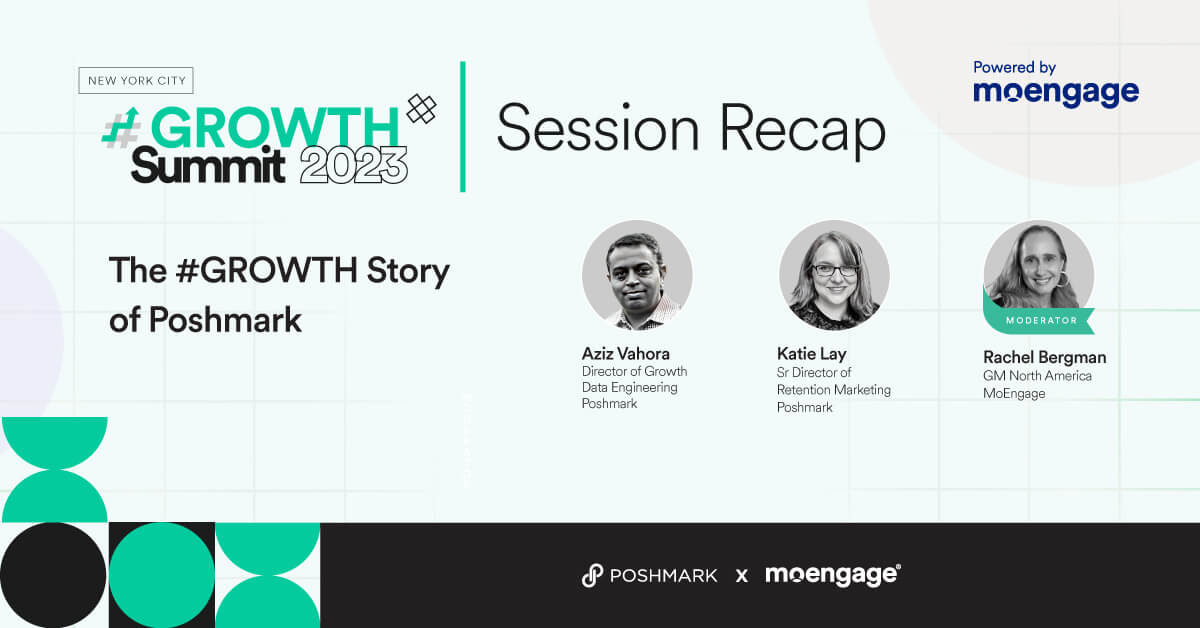The #GROWTH Story of Poshmark

Reading Time: 4 minutes
Poshmark stands out as a beacon of innovation and success in today’s ever-evolving E-commerce landscape. With over 80 million customers and 200 million listings, this bi-directional social marketplace seamlessly caters to buyers AND sellers (while maintaining zero inventory!).
To unravel the secrets of Poshmark’s success, we sat down with Katie Lay, Sr. Director of Retention, and Aziz Vahora, Director for Growth Data Engineering at Poshmark, at our first-ever #GROWTH Summit in NYC.
Leading the discussion, Rachel Bergman, GM – North America at MoEngage, explored the distinctive roles of Katie and Aziz at Poshmark and the remarkable ways they leverage data, cross-functional collaboration, and AI to elevate customer experience at Poshmark.
| Note: You can watch the session on-demand and read the takeaways below. |
Let’s dive into the key takeaways from this enlightening discussion:
Poshmark’s Unique Business Model
Unlike traditional E-commerce platforms, Poshmark is a marketplace that harmonizes the needs of both buyers and sellers. It acts primarily like a secondhand re-seller, which does not maintain inventory. Through its unique interface, Poshmark facilitates sellers to reach out to a much larger customer base than they would normally be able to. This business model makes it necessary for the brand to maintain a close relationship with its sellers and buyers.
Apart from Poshmark’s bi-directional marketplace functions, the brand focuses on nurturing communities and forging relationships with buyers and sellers, known as ‘Poshers.’
There is also an emphasis on social aspects, i.e. buyers can actively engage with sellers through various features, such as following sellers’ closets, liking items, sharing, and commenting. These interactions enable sellers to discern interested buyers and their preferences.
Building Customer Journeys at Poshmark
Apart from enabling relationships between buyers and sellers and getting “buyers in the door,” Katie and her team focus on enabling the ‘journey of discovery’ for both customer groups.
This means that she and her team aren’t just tasked with looking at single customer journeys, they also have to look at:
- Whether or not a seller has listed an item on the marketplace before
- Whether or not someone is selling
- Whether or not someone is buying
- Whether someone has done both
- Whether the buyer knows the process of becoming a seller
- Whether the buyer/seller knows Poshmark is a social marketplace
Poshmark’s Unique Challenges With Data Management
Poshmark’s bi-directional marketplace model presents unique challenges for the data engineering team, such as:
- Differentiating the listed items, as the same item could be on sale by multiple sellers
- Identifying unique characteristics, journeys, and data points for each of the customer groups, i.e., the buyers and sellers
- Making all the data points actionable for the marketing team
The Symbiosis of Data and Marketing
The session highlighted the strong partnership between Katie and Aziz’s team, which is the linchpin of Poshmark’s success. Their collaboration ensures that data drives marketing efforts with precision.
Elaborating on cross-functional collaboration, Katie emphasized the need for marketing teams to frame problems rather than pre-determining solutions while allowing data to steer decision-making.
You must intentionally build these kinds of cross-functional relationships [in the organization]. Marketing’s job is to frame the problem, not the solution, and to frame the outcome you want rather than how you wish to have it done.
– Katie Lay, Sr. Director of Retention Marketing at Poshmark
What the Future Holds for Poshmark: Generative AI and Beyond
Poshmark is currently navigating an experimental phase with AI while double-downing on retention. They launched “Posh Lens,” a user-friendly feature enabling product searches through images. This innovation has helped streamline the customer journey, making it more intuitive and efficient.
When introducing a new AI tool, we think about what we want to add and why, how it will help our end customers, how it will change their journey, and how it will make it more seamless by removing a step from that journey.
– Aziz Vahora – Director of Growth Data Engineering
Key Takeaways for Marketers Embarking on AI Journeys
Here are some best practices for marketers dealing with AI solutions, discussed during the session:
- Incorporating AI into your product/service should feel natural and solve a real purpose instead of acting like a superficial layer.
- Take time to understand your data before you implement an AI tool. Ensure the data is clean, standardized, processible, consistent, and unbiased.
- Always keep customer privacy at the core. Especially when you go through this data cleanliness process, ensure you remove any personally identifiable information and other sensitive information.
Data hygiene and cleanliness is the most important step for any AI solution. Before you embark on your AI Journeys, understand your data and ensure it is clean and standardized. Standardizing the data allows your AI to process it quickly and cost-effectively, producing a consistent and trackable output.
– Aziz Vahora – Director of Growth Data Engineering

That’s all from our discussion with Poshmark! We hope you have some valuable insights to take away from the session.
Here are some recaps and recordings of other insightful sessions that we had at #GROWTHSummit NYC 🚀:
-
Customer Journey to Nowhere: The Funny Side of Customer Engagement With Marketoonist
-
Driving Customer Engagement With Hyper-personalization and Automation
-
Delivering Immersive Experiences through Storytelling, Insights, and Data
-
Building the Modern MarTech Stack: The Ins and Outs, and the Role AI Will Play
-
The Digital Evolution of Publishers Clearing House







